Shooting stars: Lost photographs of Audrey Hepburn, Gary Cooper & Vivien Leigh by 'Speedy George'
29 July 2015
Brighton residents SHAN LANCASTER and her husband Roger knew their neighbour ‘Speedy George’ Douglas had been a photographer. But it was only after Douglas died - and his wife Jill opened up some old lockers in their basement - that they discovered an astounding photographic collection. Here were wonderfully intimate photographs of Audrey Hepburn, Gary Cooper, Vivien Leigh and much, much more. As Lancaster explains, it has been their mission not just to preserve the collection but to bring it to a wider public.
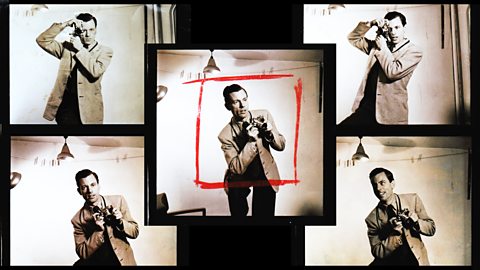
'Speedy George' Douglas | Photographer
Produced and directed by Spike Geilinger, Cinestre Films, for BBC Arts.
In 1986 we bought a house in Brighton, opposite the home of a nice old antiques dealer called George. My husband Roger was - is - a photographer and George made friendly noises about all the kit he carried. He had been a photographer himself once, but had given it up. "A young man's game," he said. We gradually became good friends.
His house was crammed with antique furniture, the walls an odd mixture of Georgian maps and prints, and badly framed 1950s magazines.

From old lockers in the basement she began producing wonderful pictures. Audrey Hepburn, Cary Grant, Shelly Winters, Mary Quant, Roger Moore, Vivien Leigh
His elegant wife Jill served generous glasses of red wine as he chatted to Roger about cameras and told a few modest anecdotes, mostly about stories he covered for Picture Post magazine in the '50s.
He gave us a print of his favourite picture, one he’d taken on the deck of the aircraft carrier HMS Indomitable in 1952.
We gathered that, in spite of his plummy British accent and the fact that he’d been born down the road in Rottingdean, he actually had American parents. That he'd given up freelancing in the early 1970s, to care for his frail old mum who lived in California.
He’d moved in with her, opening a small antique shop there to keep some money coming in.
After her death he never picked up the cameras again.
It was easier, he said, to just carry on rummaging through auctions for bargains in England in the summer and selling them in California in the winter.
This gentle lifestyle seemed tailor-made for the George we knew. No wonder he’d given up the rough and tumble of photography.
Then, in 2010, he died suddenly, and we discovered that we hadn’t known him at all.
Jill mourned him terribly, saying how sad she was that he’d been so reticent about his life and his work. She made up for it.
From old lockers in the basement she began producing wonderful pictures. Audrey Hepburn, Cary Grant, Shelly Winters, Mary Quant, Roger Moore, Vivien Leigh... and pages from the unpublished draft of an autobiography.
Audrey Hepburn, 1952
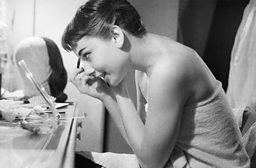
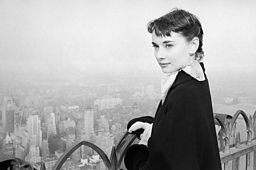
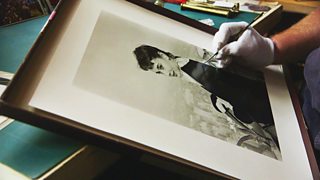
Robin Bell on printing an iconic Audrey Hepburn photograph
Another George emerged, this one anything but shy. He’d taught himself photography with a cheap camera from a pawnshop in Santa Monica, California after arriving there, via Texas, with his divorced mother.
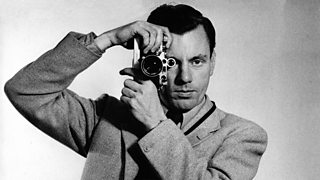
I knew this was the future and I had to work with people who were making it happenGeorge Douglas on the reportage style of Picture Post
A pushy kid, he asked anyone remotely famous or interesting-looking if he could take their picture. His work was appearing regularly in the LA Times by the time he was 18 and in Life Magazine before he was 25.
He was a charmer who could easily have made a great living as one of the photographers serving the Hollywood Dream factory (Shelly Winters had sent him flirty notes calling him “the best photographer and sweetest character I ever met”) but he was always more interested in photojournalism than notching up celebrity portraits.
He must have been the only person to quit California in 1951 for the grey skies of London. His notes about heading back were full of excitement about the gritty reportage style of Britain’s new Picture Post Magazine which specialised in 35mm. photography.
“I knew this was the future and I had to work with people who were making it happen.”
He did. Over the next five years he covered 99 features for them.
Jill wished that he’d had even one exhibition of his work and began trying to put his chaotic archive into some sort of order, but she died less than a year later. She left us the house and the archive, with the great unspoken obligation to finish the job.
It was strange doing it without her. We roped in photographer and gallery curator extraordinaire Nigel Swallow who pulled it all together and orchestrated a fabulous show of George’s work for Brighton Festival in 2014. It was a smash hit.
This year George is starring in another four exhibitions. We hope Jill would have been pleased.
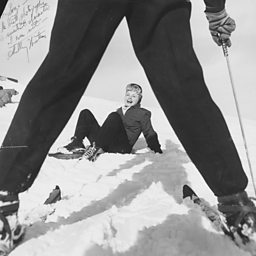
Exhibitions: George Douglas
- Audrey Hepburn, Portraits of an Icon | The National Portrait Gallery, London, until 20 October 2015.
- An Afternoon with Audrey Hepburn, George Douglas and Angela Williams | Lucy Bell Fine Art Gallery, St Leonards, Sussex, until 14 August 2015.
- George Douglas: Just In Time | Gallery ChezarthuretJanine, Arles France, as part of Les Rencontres d’Arles photo festival, July 2015.
- A new show of more recent finds from the archive is scheduled for the Brighton Photography Gallery on Brighton seafront in September 2015.
George Douglas: In his own words
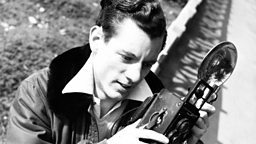
Angela Lansbury & Peter Shaw
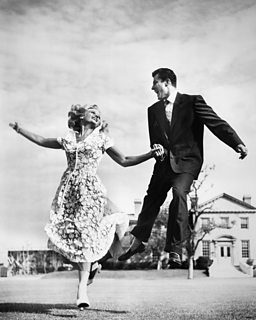
Santa Monica, California, 1949
George had been sitting in a cafe in Santa Monica wondering if he was ever going to make a decent living as a photographer…
"when close by I heard an English voice discussing his forthcoming wedding. I jumped up and introduced myself. I thought there might be the chance of obtaining a commission, as I had been photographing the occasional wedding just to get by.
Although somewhat taken aback by my sudden appearance, the groom said he thought his wife-to-be had taken care of this little matter but he would find out, if I would call him that evening.
His name was Peter Shaw, he said, but his fiancee, Angela Lansbury, might answer the phone. Angela Lansbury? The British film star? By the time I called, I had already visualised a picture of them leaping in the air for joy."
He didn’t land the wedding commission but he did persuade the couple to take that leap for him and it was used full-page in Life Magazine. We contacted Dame Angela, as she now is, to ask if she remembered the day...
"Yes, very well, I remember the young photographer, he was very sweet. But even more, I remember every detail of that dress - it was always one of my favourites".
Gary Cooper
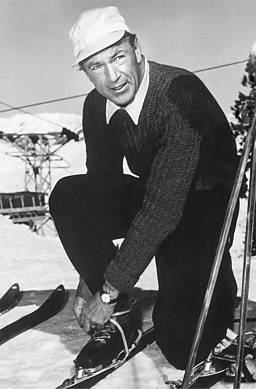
Sun Valley, Idaho, 1948
In 1948 George was working on a retainer for a ski resort in Idaho, called Sun Valley. His brief was to photograph anyone remotely famous who visited.
“Gary Cooper had never agreed to be photographed at Sun Valley, though he loved to go there. He always left very early in the morning to go skiing, so I decided to get there even earlier and wait.
It was a very cold morning, ten degrees below; he came out with his wife and daughter but they went back in because of the cold. As he was strapping on his skis by the ski-lift I asked if he would mind if I took his picture.
'Yeah', he said, and went on clipping. I waited some more.
Then he looked up and said, 'Look, fella, if you don't mind this cold, I guess I don't mind you taking my picture.'"
Mary Quant & Dalmation

Chelsea, 1964
In the 1960s George discovered the joys of working for women’s magazines and regularly shot fashion and beauty features, like this portrait of designer Mary Quant whose Chelsea Look came to define Swinging London.
The black and white palette she used is referenced in the dalmatian dog and the tones in this print illustrate what George loved about doing his own darkroom work. He wrote:
“I refused to use a darkroom assistant as I wanted full control of the finished product, even if it meant staying up all night. Every print had to be perfect. I still feel that to produce top grade work one should fulfil the complete process.
After you have the negative you still have an imperfect picture, but by making the final print you can control it by dodging and holding back certain areas.
Then the actual print can also be controlled by the amount of time it is allowed to stay in the developing solution. Therefore when you hand over the darkroom work you lose fifty percent of your control.
It is as if a painter were to rough a sketch and then have someone paint it for him. When you take a photograph you are the only one who knows what the final print should be, what depth of tone it should contain.”
Vivien Leigh

Tickerage Mill, Sussex, 1965
In 1965, after her divorce from Laurence Olivier, George photographed the actress Vivien Leigh at her home in Tickerage Mill in the Sussex downs.
She was a famous beauty who was starting to find it harder to land the right roles. His notes reflect the wistful mood of his pictures:
“I vividly recall arriving at Tickeridge Mill. A long table had been set in the garden for lunch and, while we ate, Vivien said how she wished she was a writer:
'I mean working on your own, choosing your own subjects. I have read dozens of new plays these last few months and I cannot find one to suit me. An actor or an actress cannot perform without a playwright and a theatre and an audience. All [an author] needs is a pad, a pen and a quiet room.'"
Audrey Hepburn
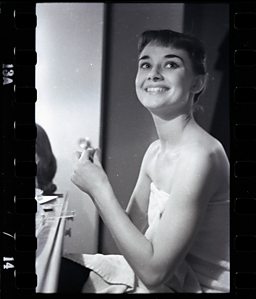
New York City, 1952
The single roll of spontaneous pictures George fired off as he chatted to Audrey Hepburn in her dressing room on Broadway in 1952 are not all pin sharp. Many of the negatives are scratched and spotted after decades of careless storage, but every single frame is beautiful.
Shan Lancaster
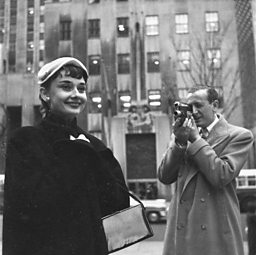

Walter de la Mare

London, 1951
Walter de la Mare was an English poet, short story writer and novelist. George went to photograph him in 1951, for a Picture Post feature called Are Poets Really Necessary?, and wrote:
“What transpired has affected me since. As I recall, he lived in an upstairs room at the end of a cul-de-sac behind Olympia. The space was quite confined, so I asked him if I might climb on the furniture after I removed my shoes. He smiled and agreed."
As he watched this young man in his twenties leaping around, de la Mare suddenly broke the silence:
'I envy you. To you I am an old man, but in my mind I am as young as you are at this moment. But with age, the body becomes a prison; every day the bars get tighter. I remain youthful in my thoughts but incarcerated in the body, and finally it will finish me. For my mind is forever young and does not grow old.'
George would have been over 80 himself as he added:
“Now that I myself begin to feel the bars, and the jail the body will become, I really think he had summed it up correctly. That day I took one of my best portraits.”
The Goons, 1954
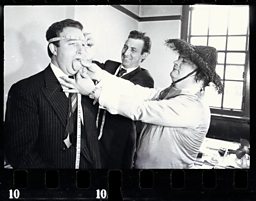
Roger Moore, 1958
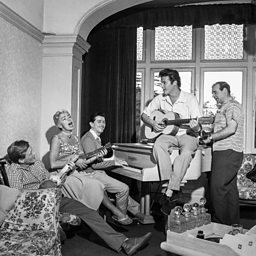
Diana Dors, 1957

George Douglas

More photography from BBC Arts
-
![]()
War and peace
The compassionate photography of Don McCullin.
-
![]()
Childhood in the 1970s
Tish Murtha’s tender photos of deprivation in Britain.
-
![]()
Neon dreamland
Liam Wong's sci-fi-style images of Tokyo at night.
-
![]()
Pup art
William Wegman's Polaroids of his loyal Weimaraners.
-
![]()
Stanley Kubrick
1940s New York through the lens of teenage Stanley Kubrick.
-
![]()
Jailhouse Rock
Behind-the-scenes photos of Johnny Cash's prison shows.
-
![]()
The real Sin City
Hard-boiled photographs tell the history of crime in LA.
-
![]()
10 years with Kate Bush
Rare photographs of the singer at the height of her career.








